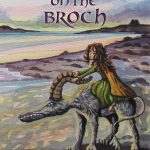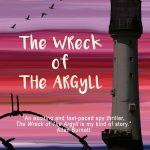Tell me what inspired you to write about your latest book?
When I was eight, my lightkeeper Dad was posted to Tarbat Ness Lighthouse in North-east Scotland. This was the first time we’d ever lived actually at a lighthouse, and from the ages of eight to eleven it was the most amazing place to grow up, with wide-open spaces and rocky coves. There were even stories of Viking battles on the peninsula, and one old bloke once told me and my brother that the hummock just outside the lighthouse walls was probably a Viking burial mound. That can’t help but fire your imagination! Tarbat Ness has always had a special place in my heart, and three years ago I was reading up on recent archaeological finds – there was a Pictish monastery in the nearby village of Portmahomack which showed signs of being destroyed, possibly by Vikings, in about 800AD. There were stone carvings found, too – symbols, animals, dragons, and the enigmatic Pictish Beast, the long-nosed, horned creature sometimes known as the Pictish Elephant or the Pictish Dragon. (No-one knows what it really was!) I put them all together and came up with the story of The Beast on the Broch.

Do you try and read the online reviews you get on say waterstones website?
I do – whatever the review, whether a one-liner or a long, involved dissection, I’m mostly grateful that someone has read my work and taken the time to put their thoughts down.
Is there anything you wouldn’t write about?
I doubt I’d ever write anything contemporary and realistic. I’m interested in history (the older the better), fantasy, and science fiction.
How hard do you find it to keep within an age category?
My novels tend to fall naturally into the 8-12 age group. It’s not something I set out to target – in fact, when I started writing, I was writing for grown-ups. I still write short stories for adults, too. The limitations I place on myself for the middle-grade novels tend to be the somewhat arbitrary considerations of editors and agents, like word count and the use of semi-colons.
What did you do before becoming a writer?
I’ve always been a writer! Well, sort of. For the past 20-something years I’ve been a technical author in the software industry. Which is just like being a writer, only incredibly boring.
Which author inspires you?
My first novel, The Wreck of the Argyll, was very strongly inspired by Allan Campbell MacLean, especially his Cold War spy thriller The Hill of the Red Fox. Since I was a teenager, Iain Banks has been a constant inspiration for his inventiveness and humanity. More recently Abi Elphinstone, with her thrilling stories of Moll and Gryff, has inspired me to make my tales wild and fun.
Which genres do you read yourself?
Science fiction, fantasy, historical fiction.
What is your biggest motivator?
The fear of frittering away my life. I sold my first short story at 19, then somehow managed to waste decades on magazines that died before they could publish my subsequent stories, followed by a succession of partially-written novels that petered out around chapters 3 to 6. I was in my early 40s by the time I completed a novel, and mid-40s by the time I saw one published.
What will always distract you?
Twitter. It’s evil. But without it I wouldn’t have such a great circle of writing buddies to share the journey.
How much say do you have in your book covers?
For The Wreck of the Argyll, there was a competition for Dundee school children to design the cover. I got to pick the winner, and then Michael Gallacher was hired by Cargo to produce the artwork based on Qynn Herd’s winning design.
For The Beast on the Broch, Cranachan hired artist Dawn Treacher with a strong idea of what they wanted, and I was involved in details like the look of the beast, or what Talorca was wearing. I was also consulted on variations on the design and we worked together to decide on the layout.
As a child were you a great reader?
Oh yes. My Mum taught me to read before I started school, and if there’s one thing my parents never skimped on, it was books. I had a huge stack of my own books, and I was never out of the library. The book clubs like the Chip Club and Bookworm were the best part of school, and the day that the ordered books arrived was always as exciting as Christmas for me. My secondary school, Portree High, had its own bookshop! I spent nearly every lunchtime there or in the school library.
Which book shop is your favourite?
Until it closed down a couple of years ago, the Foyles in St Pancras was my favourite. After a trip to London, which probably involved buying lots of books anyway, there was always room for just one more before getting the train back to Leicester. There’s a Hatchard’s in St Pancras now, which is OK, but it’s not quite the same.
What can you not resist buying?
99p Kindle deals.
Do you have any rituals on your writing days?
I set a target for the each writing session in Scrivener of 1000 words, and force myself to get across that line even if it’s total gibberish I’m writing. (You can fix anything with a good edit.) The urge to give up at around 400 words can be overwhelming, but I find that if I can break the 1000 word mark, then another 500 words or so will come quite easily.
The other ritual is more of a trick – I leave the last sentence half-completed. That means when I come back to the manuscript, I don’t have to think too hard about what to write next, and before you know it I’ve completed the last sentence and I’m onto the next.
How many books in your own to be read pile?
Um. Let’s not talk about my Kindle, which has a problem with impulse 99p bargains and no restriction on shelf space. For physical books, I have (goes to count) about 30 books.
What is your current read?
Fir for Luck, by Barbara Henderson – it’s an ARC sent to me by my publisher Cranachan, and it’s an amazing story of bravery during the Highland Clearances. (I often have a second book on the go at the same time, which I read on my Kindle app on my phone at lunchtimes at work – by coincidence, my current lunchtime read is the Booker-longlisted His Bloody Project, by Graeme Macrae Burnet, which is a story of brutality in the times of the Highland Clearances…)


